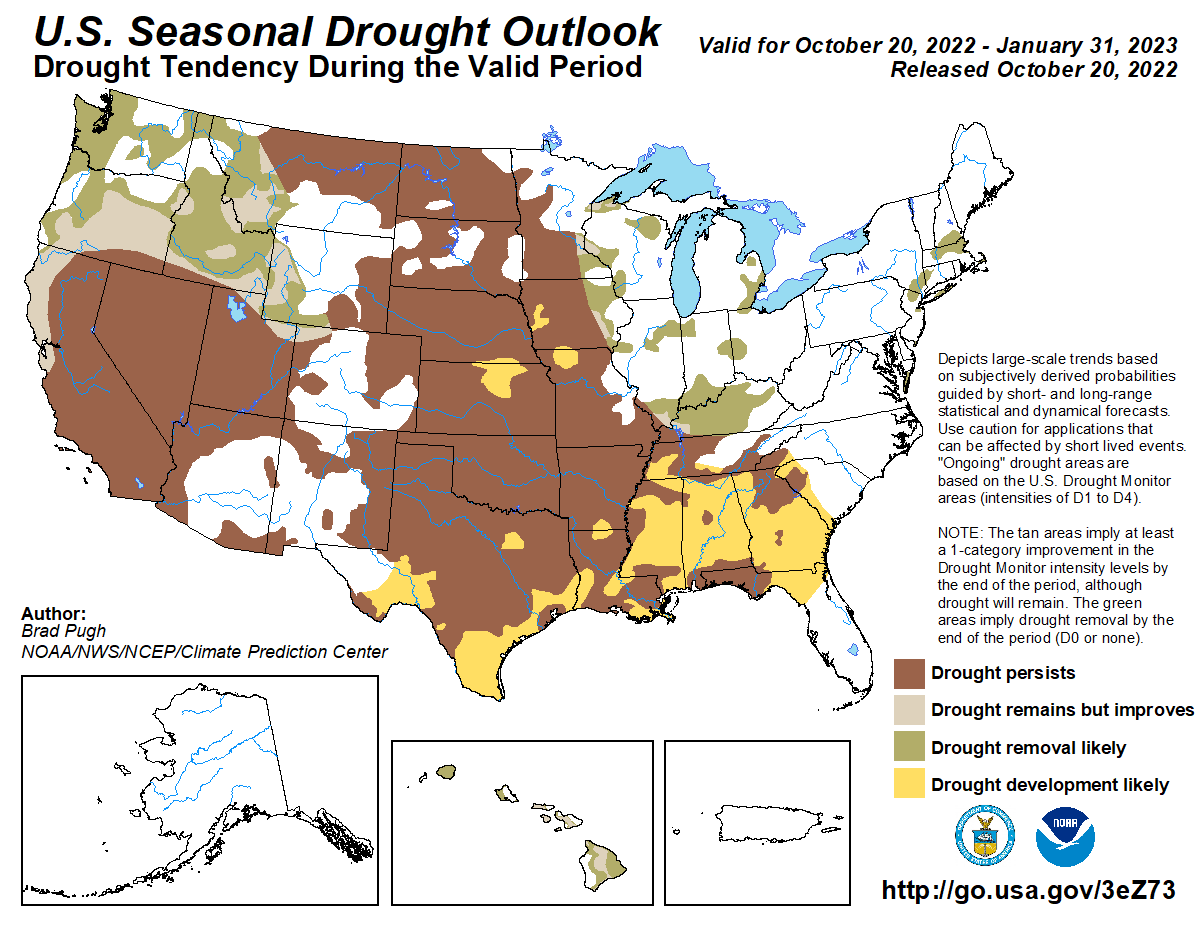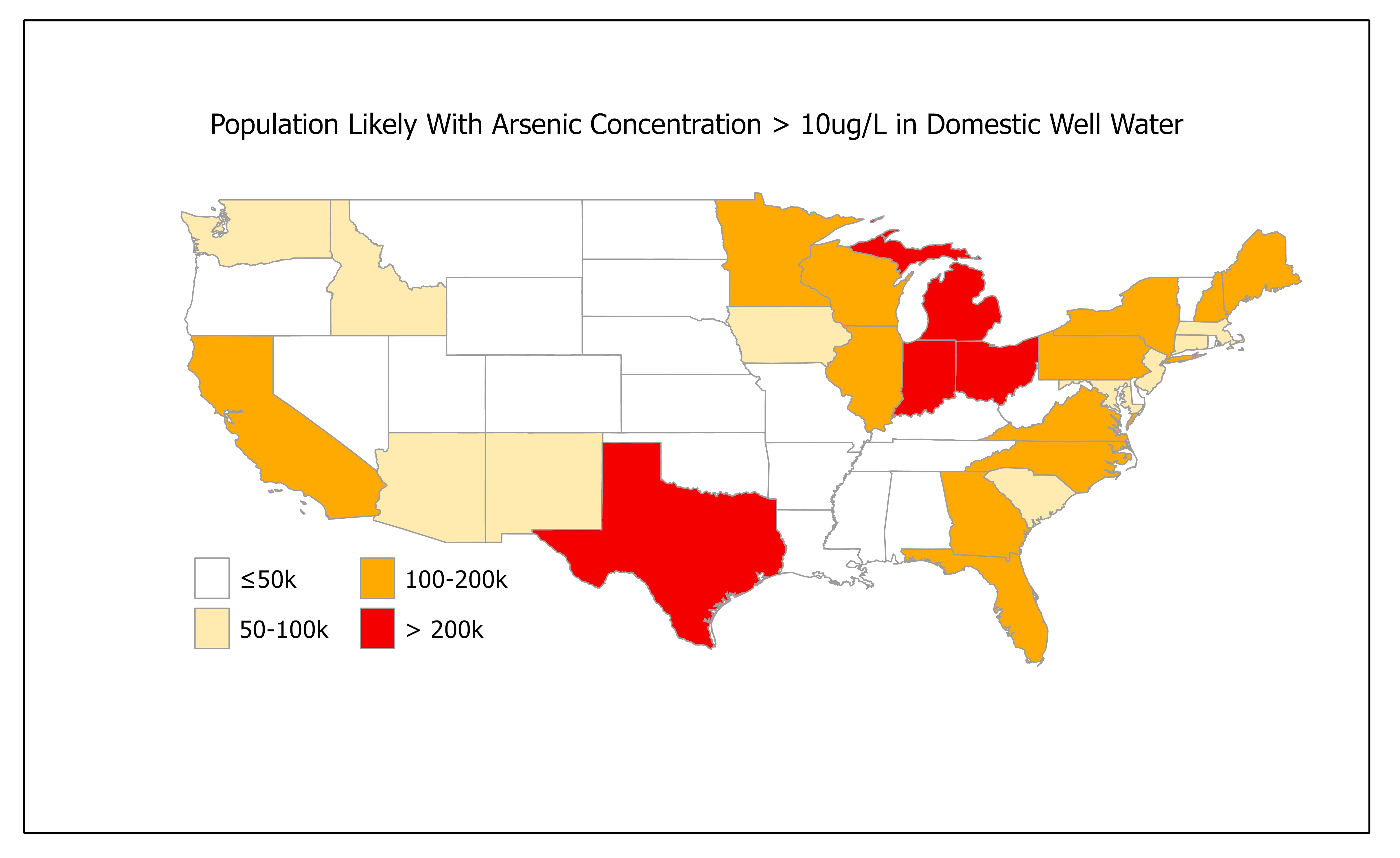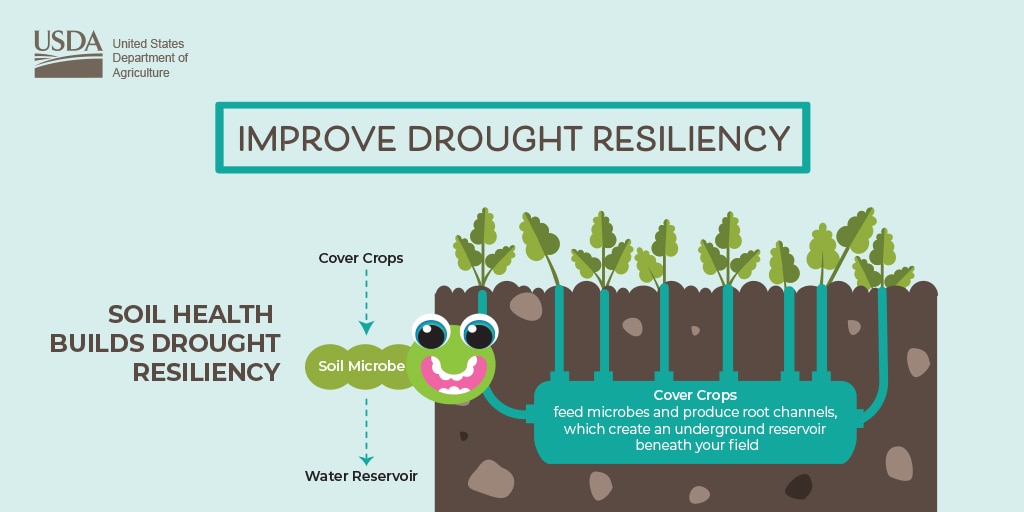
Figure: The National Weather Service Climate Prediction Center's Monthly Drought Outlook is issued at the end of each calendar month and is valid for the upcoming month. The outlook predicts whether drought will persist, develop, improve, or be removed over the next 30 days or so. For more information, please refer to drought.gov.
Drought has expanded and intensified across the Pacific Northwest, Great Plains, Mississippi Valley, Ohio Valley, and Southeast since mid-September. This large drought expansion was due to an unusually dry September and a continuation of a dry pattern into early October. Improving drought conditions were limited to the East Coast and Southwest. Drought coverage decreased in recent weeks along the East Coast and drought is expected to end across the Northeast during the winter. Along with typically wet La Niña impacts, improvement or removal is forecast for the Pacific Northwest. This improvement or removal extends eastward to the north-central Rockies and southward to coastal northern California due in part to a relatively wet climatology during November through January. For the remainder of California and the Southwest, broad-scale persistence is more likely. Drought is also likely to persist with additional development across the Great Plains and Southeast. Drought improvement or removal is forecast for Hawaii, consistent with La Niña impacts and entering into their wet season. Alaska and Puerto Rico are likely to remain drought-free through the end of January 2023.
Drought Affects Health in Many Ways
Drought increases the risk for a diverse range of health outcomes. For example:
Low crop yields can result in rising food prices and shortages, potentially leading to malnutrition.
Dry soil can increase the number of particulates like dust and pollen that are suspended in the air, which can irritate the bronchial passages and lungs.
Dust storms can spread the fungus that causes coccidioidomycosis (Valley Fever).
If there isn’t enough water to flow, waterways may become stagnant breeding grounds for disease vectors like mosquitos as well as viruses and bacteria.
Drought's complex economic consequences can increase mood disorders, domestic violence, and suicide.
Long-term droughts can cause poor-quality drinking water and leave inadequate water for hygiene and sanitation.
Drought and Arsenic in Domestic Wells

Figure: Map showing the probability of having arsenic >10 μg/L (“high arsenic”) in domestic wells during drought. Arsenic occurs in groundwater due to chemical reactions between the rocks and water, lowering of water levels due to drought may cause chemical changes that release more arsenic from the rocks. Less water could also concentrate existing arsenic in the water. Hotspots generally reflect areas in the U.S. with high observed concentrations including New England (predominantly Maine and New Hampshire), a band in the upper Midwest, the southwest (most notably Nevada, southern Arizona, southern and central California, and isolated regions in all western states), and southern Texas.
Drought conditions can lead to elevated levels of naturally occurring arsenic in the water we drink. The risk of contamination increases the longer that a drought persists. In a study done by U.S. Geological Survey and Centers for Disease Control and Prevention in 2021, researchers estimated that over 9% (4.1 million) of the 44.1 million people in the lower 48 states who use private domestic wells were potentially exposed to unsafe levels of arsenic during drought conditions compared to about 6% (2.7 million people) during non-drought conditions. Chronic exposure to arsenic from drinking water is associated with an increased risk of several types of cancers, developmental issues, cardiovascular disease, adverse birth outcomes and impacts on the immune and endocrine systems.
Resources to Reduce Health Risks Associated with Drought
Drought poses many and far-reaching health implications. Some drought-related health effects occur in the short-term and can be directly observed and measured. But the slow rise or chronic nature of drought also can result in longer term, indirect health implications that are not always easy to anticipate or monitor.
General Preparedness
The Centers for Disease Control and Prevention (CDC) Drought and Health site and Ready.gov Drought site have information on the health implications of drought and how to prepare. The U.S. Drought Portal provides data, decision-support products, resources, and information on drought.

Image source: https://www.cdc.gov/nceh/hsb/cwh/docs/CDC_Drought_Resource_Guide-508.pdf
For Farmers
The Department of Agriculture offers programs that can help with drought recovery as well as those that can help farmers manage risk and build resilience. The Department’s Climate Hubs feature regional resources including vulnerability assessments and tools and a Climate, Agriculture, and Forest Science Webinar Series.
The U.S. Drought Monitor is an online, weekly map showing the location, extent, and severity of drought across the United States. The Department of Agriculture uses the Drought Monitor to determine a producer’s eligibility for certain drought assistance programs. You can report drought-related conditions and impacts within the U.S. and associated territories to the Drought Monitor.
The Department of Agriculture’s Natural Resources Conservation Service can help farmers conserve water and build resilience to drought, through conservation practices that improve irrigation efficiency, boost soil health, and manage grazing lands.

Image source: https://www.farmers.gov/blog/making-your-land-more-resilient-drought
Mental Health
Drought is a slow-moving hazardous event, so the psychological effects of living through this type of disaster are more subtle and last longer than with other natural disasters. The Substance Abuse and Mental Health Services Administration (SAMHSA) Helpline and Text Service is available 24/7, free, and staffed by trained crisis counselors. Call or text 1-800-985-5990 to get help and support for any distress that you or someone you care about may be feeling related to any disaster.
Funded by the Federal Office of Rural Health Policy within the Health Resources and Services Administration, the Rural Health Information Hub offers several resources about drought and other stressors farmers face, as well as information and resources about farmers' mental health and prevention of suicide among farmers.
Learn more about drought and mental health at the SAMHSA’s Drought site. SAMHSA also has other disaster behavioral health resources, including newsletters and tip sheets. Check out SAMHSA’s newly launched Climate Change and Health Equity site for more information on the behavioral health impacts of climate change, preparing for a disaster, and resources for disaster planning and climate change education.
Best Practices for Emergency Mangers
The CDC’s When Every Drop Counts: Protecting Public Health During Drought Conditions—A Guide for Public Health Professionals is intended to assist public health officials, practitioners, and other stakeholders in their efforts first to understand and then to prepare for drought in their communities. It provides information about how drought affects public health, recommends steps to help mitigate the health effects of drought, identifies future needs for research and other drought related activities, and provides a list of helpful resources and too.
The CDC’s Preparing for the Health Effects of Drought: A Resource Guide for Public Health Professionals supplements When Every Drop Counts and is based on the results of a qualitative analysis of in-depth interviews with public health professionals, a review of state drought plans, and a literature review.

